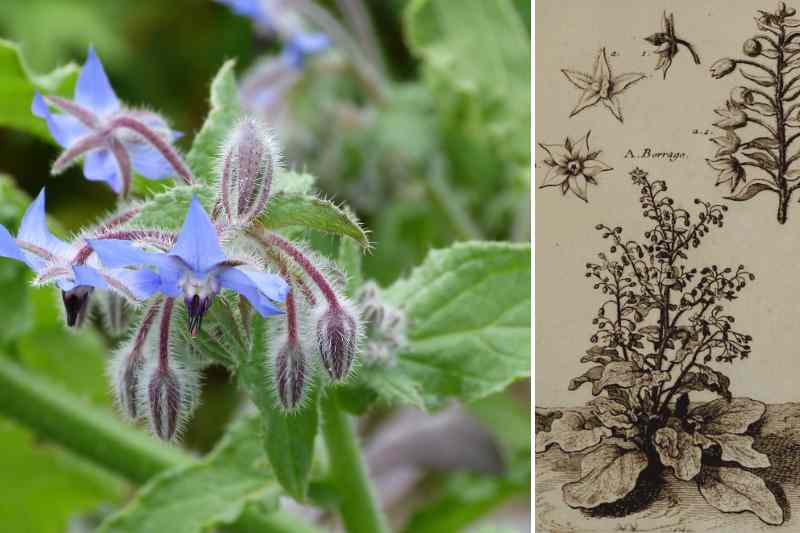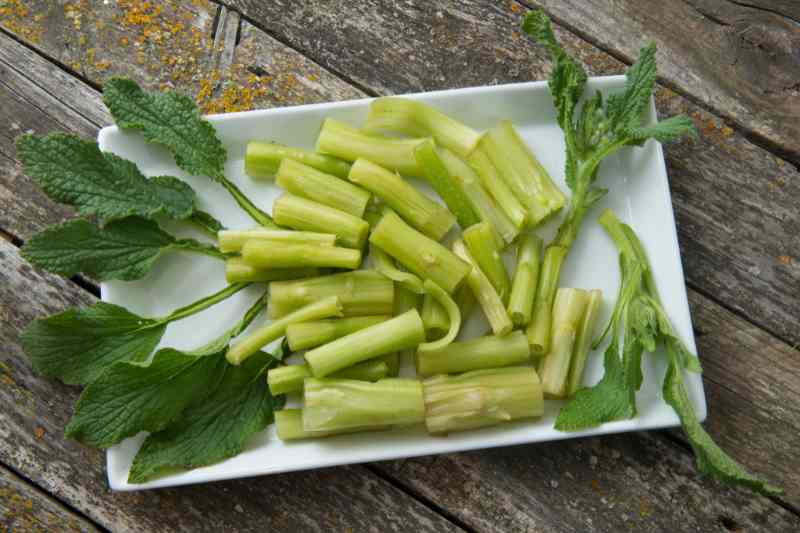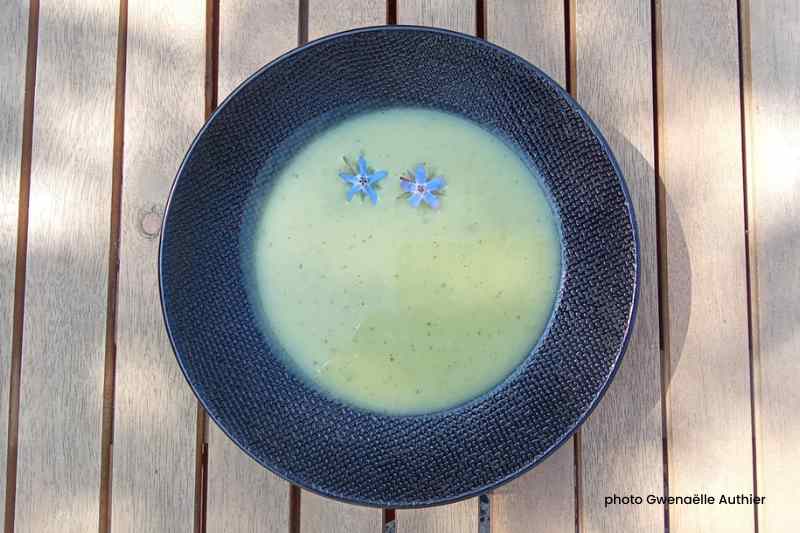When, like me, I'm overrun with borage in my vegetable garden, I wonder how to use all those leaves to good use. I usually use the pretty little star-shaped flowers, with their iodine flavour, raw to decorate summer salads. But what about using its many coarse, aromatic leaves in the kitchen? One of the simplest and tastiest ways is to make a soup from borage leaves. Want to try? Here is an idea for a rustic, original green soup to enjoy cold or hot and savour in every season.
Cooking borage: a trip back in history
In Antiquity, borage was credited with powers such as reducing fever or chasing away sad humours. Leaves were then added to macerate in wine. In Middle Ages, when many sorts of "greens" were widely used (patience or Rumex, fat‑hen or orache, and borage…), it was used in cooking, in borage broths. Later, La Quintinie grew it at Potager du Roi in Versailles alongside salad burnet, and Olivier de Serres in the 17th century also found it interesting to include cooked leaves in certain dishes, notably soups.
Today, avant‑garde chefs are rediscovering it and featuring it in gastronomic versions!

When to harvest borage leaves for cooking?
As soon as it grows well, mid‑spring! For cooking, use young, fresh leaves. No point trying to dry them — they will blacken. So it is in May and June that borage is most often used in the kitchen.
You can cut it with bare hands, even if the rough feel of stems and leaves is a little unpleasant; you can always wear thin gloves to make it more comfortable (it's not nettles, after all!).
Wild borage has that slightly annoying tendency to spread too much by sowing. New plants therefore often appear during the summer. Leave a few to develop well so you can harvest both their flowers and leaves later in summer, up to September. Cutting it back after flowering will also encourage it to regrow.
Pick whole, thick, hairy stems, as these will also be used to prepare the soup. The small hairs on the leaves are not a problem for making a soup (but should be removed if you plan to use the young leaves for other preparations such as fritters, for example).

Borage in cooking
Native to Spain and the Mediterranean basin, look to the Iberian Peninsula when integrating this medicinal plant into cooking. Borage is used in many traditional dishes from the Aragon province in north‑east Spain. It is sometimes used in ravioli di magro in Italy — Lenten ravioli, without meat, made from greens and ricotta — and is also consumed in Portugal.
Rich in vitamin C and mineral salts, only one or two handfuls are added to a soup for their powerful flavour (a cucumber‑like taste), but mainly because they contain substances toxic to the liver. To enjoy them in soup, briefly boil the leaves beforehand. Fresh leaves are used in our recipe simply to flavour the soup.
Why associating borage with soup?
Within the wide family of green soups, borage adds a refreshing note. Since it can't be used alone — the soup would be too strongly flavoured — it is interesting to blend it with others.
Its fresh flavour lends itself to pairing with other leafy vegetables. Choose preferably green leaves to create a velvety soup as lovely in colour as it is tasty. There are many options: leek (white part), green cabbage leaves, chard, spinach, beet leaves, nettle, purslane, orache, and, in small quantity, sorrel leaves to add a slightly tangy note.
Borage leaf soup
Ingredients
- 2 potatoes
- 1 handful of borage leaves and stems, about 100 g
- 400 g of green vegetable leaves of your choice (spinach, chard, rocket) or leek, courgette, etc.
- 1 large yellow onion
- 1 clove of garlic
- single cream (facultative)
- 1 tbsp olive oil
- Strip leaves from borage.
- Rinse herbs, then roughly chop stems into small sections and chop leaves. You can peel the fuzzy part of the stems, but this is not essential.
- Place leaves in a bowl of iced water for a few minutes or blanch them very quickly, just covering with boiling water.
- Set leaves aside, reserving the cooking liquid (it contains the mucilaginous sap from leaves and stems, which slightly thickens the soup).
- Peel and cut potatoes into small pieces and slice garlic and onion.
- Sauté onion, sliced garlic and borage stems in olive oil in a saucepan.
- Add borage leaves, cover them with the reserved broth to just reach the vegetables, no more. Add a drizzle of olive oil.
- Cook for 15 minutes.
- Blend everything, then pass through a fine sieve and season with salt.
- Optionally garnish with small croutons fried in olive oil, pieces of cured ham or grated sheep's cheese as done in Spain, or a drizzle of single cream.
NB: this green velvety soup can be enjoyed hot or very cold.

Variations
You can replace olive oil with sesame oil and vary flavours according to the aromatic herbs and leafy vegetables you have at home.
For a richer version, replace the drizzle of cream with a small spoonful of mascarpone whipped with wild garlic powder or a good pepper, placed as a creamy quenelle on the soup.
For high summer, you can also make a chilled version like a pea‑and‑borage cream. I've personally tried it in small aperitif verrines with a thicker consistency for a surprising mouthful... a real success!
Learn more
To learn more about this melliferous plant useful in vegetable garden, consult our full dossier on borage: Borage: sowing, harvest, benefits, our advice sheet How to dry borage and our video borage with white flowers.
Ingrid gives other ideas for zero‑waste soups with: Zero waste: how to recycle radish tops? and Zero‑waste soup.
































Comments